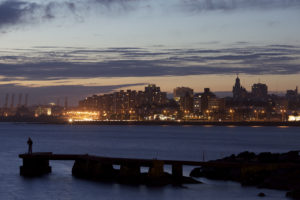Writers are not paying enough attention to climate change, novelist Amitav Ghosh had lamented. Artists are.
This June, at the second annual meeting of the Planetary Health Alliance, there was a special session on “art and climate change” amid all the talk among scientists, policy specialists, research institutes and governments, because many people realise that the challenge posed by climate change cannot be overcome through science alone.
Through new works and collaborations, artists are increasingly helping to sound the alarm on climate change, and they are going beyond.
Arts and climate change
A new study led by Diego Galafassi at the Stockholm Resilience Centre says, “The arts are moving beyond raising awareness and entering the terrain of interdisciplinarity and knowledge co-creation.” The study positions the arts as a key element to drive action that can combat climate change. Some artists now feel they can impact cultural change, from which possible solutions to climate change may emerge.
In India, artists are working on projects, public installations, dance and public workshops that look at various facets of the challenges being faced by the environment. They think it is important to do so, because “Art moves you in ways that you cannot articulate. There’s something to be said about the effect of art – something moves you to action where facts and information don’t,” says Radha Mahendru of Khoj, a New Delhi based artists’ collective.
In recent years, a number of public art installations have addressed the topic with the aim to bring the conversation into the living room. In the Toxic Lanes of Your Cities, an installation created by contemporary multimedia artist Owais Husain, focused on the effects of industrialisation and globalisation on the environment in major Indian cities like Mumbai, Delhi and Bangalore.

Volume 31, April 2018
In June this year, the Mandi House metro station in Delhi was host to a photography exhibition by French researcher Remi de Bercegol on the lives of those working in the waste industry in and around the capital. The project forced the audience to rethink their lifestyles and habits and their impact on the planet.
Chinese artist Tan Xi, whose installation Plastic Ocean was part of the St+Art India’s Sasoon Art Project organised in the Mumbai last year, worked with over 400 kg of plastic to raise awareness about the growing problem that is polluting Mumbai’s coasts. Using mirrors, the artist emulated the feeling of being trapped inside a plastic ocean.
Also see: Collective insanity through another lens
Delhi based visual artists Gargi Chandola and Yaman Navlakha asked New Delhi Municipal Council for permission to graffiti the walls of waste collection centres. Following the theme for this year’s World Environment Day (“Beat Plastic Pollution”), the artists painted a multi coloured mural to highlight this issue. According to the UN, each year at least eight million tons of plastic end up in the oceans, the equivalent of one full garbage truck every minute.
“We found in our research that direct messaging on these topics isn’t very effective, so we decided to approach it in a way that doesn’t seem monotonous to people,” says Chandola.
The Galafassi-led study also says that art projects can foster dialogue amongst and between various sectors, creating extended networks amongst artists, scientists and society. Khoj’s project Landscape as Evidence: Artist as Witness, was a staged hearing based on the case of interlinking rivers in India. The project considered reinterpreting the language of the law through art, allowing new vocabularies to conceive and speak about the environment and climate change and thus finding innovative ways of relating to ecological events.
In West Bengal, a dance company used the folk dance form Chhau and put climate change at the centre of its production “Ekanoma”. Mother Earth is depicted as a woman in agony due to the destruction that humans have caused to her.
The study does acknowledge that although the role of arts in the climate change debate is important and essential, the impact of such projects is yet to be determined. It is yet to be seen if set goals were achieved and if these art-based climate projects might have contributed to any transformation.
Art allows us to make an emotional connection with climate change, one that goes beyond data and facts. Artists play an important role as positive accelerators of change. Art provides a way to express and remodel the society we want, and in the end can help us reconstruct our relationship with our planet.







![Peafowls have become a menace in LunchaKameru village in Sumbuk block of South Sikkim, so every morning desperate villagers go to an open patch of land in forest to spread feed for peafowls in the hope that their crops will be spared. They have also constructed water basins out of bamboo [image by: Nidhi Jamwal]](https://dialogue.earth/content/uploads/2018/08/HWC1-300x172.jpg)
